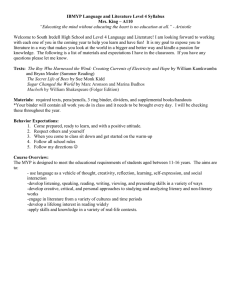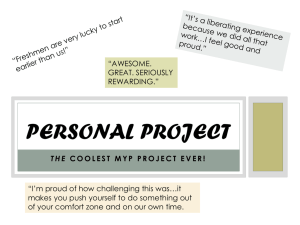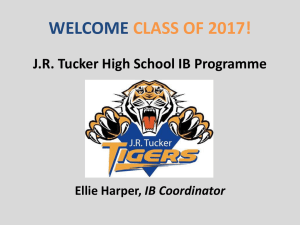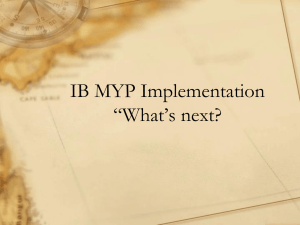Introduction to Middle Years Programme (MYP)
advertisement
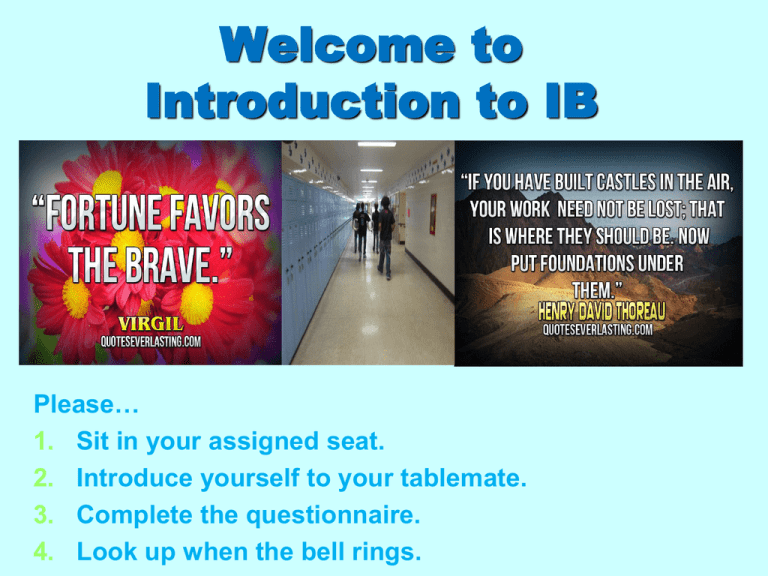
Welcome to Introduction to IB Please… 1. Sit in your assigned seat. 2. Introduce yourself to your tablemate. 3. Complete the questionnaire. 4. Look up when the bell rings. Ms. Berndt – “Ms. B.” Learning Intentions Success Criteria We are learning (to)… We’ll know we’re successful when: • about this course (i.e. what it • we understand the information in the course syllabus • we can describe the class in our own words and feel comfortable sharing that description with our families • we understand the rules, consequences, and procedures for Rm. 203. • we know more names of fellow students than when we entered the classroom and we know enough about our tablemate to introduce him/her to another student. is and what the goals and objectives are for the year) • how to be successful in Room 203 • about our classmates and our teacher. Agenda Teacher Introduction Reagan Paperwork – A1 only Fact or Fiction 52 Questions Course Syllabus & Procedures (MYP Lingo and Notes) Homework Welcome to Introduction to IB 2 1 1. Place the homework in the A1 basket (i.e. the student questionnaire – due today and last page of your syllabus – due Mon.) 2. Sit in your assigned seat. 3. Get out a piece of paper. 4. Respond to the following two questions in writing: Do you agree or disagree with Quote #1? Why? Do you believe Quote #2? Why or why not? Learning Intentions Success Criteria We are learning (to)… We’ll know we’re successful when: •about our classmates and our teacher • how to be successful in Room 203 • about this course (i.e. what it is and what the goals and objectives are for the year) • about the IB program – specifically MYP and all of its “lingo” • we know more names of fellow students than when we entered the classroom and we know enough about our tablemate to introduce him/her to another student • we understand the information in the course syllabus • we understand the rules, consequences, and procedures for Rm. 203 •we know what IB, PYP, MYP, DP, LP, AoI, and GC mean • we can describe the class in our own words and feel comfortable sharing that description with our families Agenda Think-Pair-Share Review Syllabus Sharing is Caring Fact or Fiction (A1 Only) MYP Lingo and Notes Fear in as Fishbowl – Exit Slip Homework – Syllabus & Materials Introduction to Middle Years Programme (MYP) What is the IB Middle Years Programme? For students aged 11 to 16 Encourages students to embrace and understand the connections between traditional subjects and the real world. Become critical and reflective thinkers. The Curriculum Eight subject groups Students are required to study their mother tongue, a second language, humanities, sciences, mathematics, arts, physical education and technology. Five Global Contexts (Areas of Interaction) Students also engage in the Personal Project, which allows them to demonstrate the understandings and skills they have developed throughout the program. Subjects Language A Language A is defined as the student’s best language. Language B The primary aim of language B is to encourage students to gain competence in a modern language other than their mother tongue, with the long-term goal of balanced bilingualism. 8 Subjects Humanities geography history economics politics civics sociology anthropology psychology Sciences • biology • chemistry • physics • environmental • anatomy Mathematics Mathematics in the MYP aims to provide students with an appreciation of the subject’s: usefulness power beauty The Arts visual arts performing arts Physical education The aim of physical education in the MYP is to facilitate your “holistic” development: physical intellectual emotional social Technology More detail to follow… MYP prepares you for your junior and senior years of IB education at Reagan …. Certificate/ Course Student IB Career Certificate Student Full Diploma Student Keep in mind: • Your decision is made at the end of your sophomore year. • Your performance in your MYP course can affect your options. Global Contexts formerly known as “Areas of Interaction” Approaches to Learning Community and Service Human Ingenuity Environments Health and Social Education Technology We’ll use the Design Cycle as a vehicle for solving real-life “problems”, such as: Learning Styles Study Skills IB Learner Profile 7 Habits of Highly EffectiveTeens Computers and Technology Personal Project Outcomes (i.e. year-long success criteria…) We’ll know we’re successful when we… understand how our learning styles and the IB Learner Profile traits help us to be successful in school, at home, and in our community; develop an appreciation of the significance of technology for life, society and the environment; use knowledge, skills and techniques to create products/solutions of appropriate quality; We’ll know we’re successful when we… develop problem-solving, critical- and creativethinking skills through the application of the design cycle; develop respect for others’ viewpoints and appreciate alternative solutions to problems; use and apply information and communication technology (ICT) effectively as a means to access, process and communicate information, and to solve problems. Fear in a Fishbowl fear doubt worry anxiety Anonymously complete one of the following sentences on a piece of paper… “In this transition to high school, I am (most) afraid that…” OR “In the first month of being a freshman the worst thing that could happen to me would be…”
